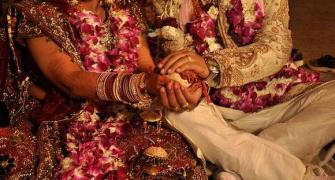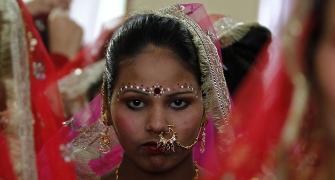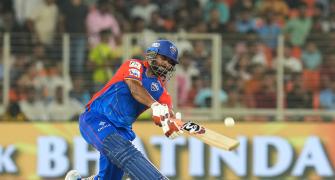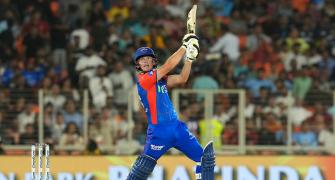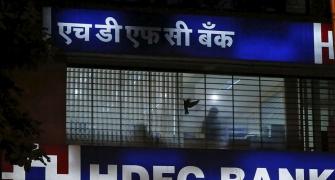'On the face of it, it is a WYSIWYG -- What You See Is What You Get -- reality series, but actually it is a show that perpetuates societal biases, stokes typecasts and stays sadly superficial,' notes ad guru Sandeep Goyal.

Since its release, Indian Matchmaking has raced to the top of the charts for Netflix in India.
And it has hit No 10 in the US.
The show has also become a massive social media phenomenon.
Hundreds of memes and jokes have been shared on multiple sites: Some say they are loving it, most insist they are hating it; but they are all cringe-watching the eight-part docu-series featuring matchmaker Sima Taparia ("from Mumbai") as she goes about trying to find suitable matches for offspring of wealthy clients in India and the US.
The in-your-face misogyny, the unabashed casteism, the blatant colourism, the stereotypical sexism have all caused much outrage and derision, but also hopefully inspired some hard introspection.
Episodes titled Slim, Trim and Educated, Just Find Me Someone, It's High Time and Adjustment and Compromise, provide ready context to the show content.
Is it a cut-to-fit documentary about upper-crust Indians, both desi and Diaspora that panders to Western audiences who are supposedly sniggering at our prejudices and predilections for what we call an 'arranged marriage'?
Or is it a realistic portrayal of how match-makers play Cupid for 'tall, slim, fair and flexible' girls and highly entitled, indecisive, pompous boys whose 'mamas' are more difficult to satisfy than their pampered sons?
When Danny Boyle made Slumdog Millionaire in 2008, it became an overnight success across the globe.
The film was nominated for 10 Academy Awards in 2009 and won a record eight (the most for any 2008 film).
It won seven BAFTA Awards, five Critics Choice Awards and four Golden Globes too.
However, in India, the film faced severe criticism for being a white man's 'imagined' India; with Indians fuming that it fuelled Western stereotypes about our country and poverty, especially the disdainful and distasteful depiction of our slums.
So there was no pride, just petulance and prejudice, about a film on India ... all shame, no fame.

Interestingly, another Netflix show,Never Have I Ever, a 'maladroit' coming-of-age comedy drama about an Indian American teenager that released this May, has also drawn massive flak for its tone-deaf stereotypical depiction of the South Asian community.
The show triggered a huge debate about the need for a balance between being 'Indian' and living the American life, and whether someone can be 'too Indian' or 'not Indian enough' as portrayed in many first-generation American shows.
The same debate kind of extends to Indian Matchmaking, especially in the character of Nadia who is Guyanese, but still craves her Indian identity in an all-American life where she says, 'I fill my time so I don't realise how single I am...' and one is not too sure whether that is self-pity, or just a matter-of-fact status check.
It is actually the Diaspora characters in Indian Matchmaking that I found more intriguing, more vulnerable.
None of them was really a non-resident Indian or an overseas citizen of India -- the usual epitome of Indian-ness, embodying at once capitalist and consumerist modernity and patriarchal, Northern and Hindu traditionalism; they were first or second generation Americans of Indian origin.
Independent, feisty, successful, self-confident and articulate.
Their body language, even their accents were by-and-large American-ish.
But the roots, the anchoring of values (whatever they are supposed to mean), the thought process was very 'Indian'. That freaked me out.
Why try and be 'Indian' when everything else about you is anything but that. Except your brown skin.
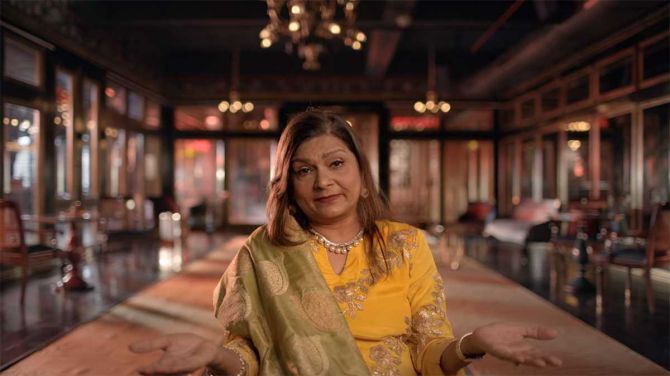
'Adjustment'/ and 'flexibility' versus 'stubborn'-ness is another parallel theme that permeates the entire show.
Especially when Sima Aunty counsels the many girls on how an 'arranged marriage' works, while concurrently pampering entitled boys -- pandering them with 100-150 proposals which they reject because they "are not ready" for marriage.
Abominable, yes. Obnoxious, yes. Unreal? Untrue? No.

So, why is Indian Matchmaking pivotal, and not seminal?
Pivotal, because for once the Diaspora characters have not been put on a pedestal.
Or for that matter been caricaturised.
They've not been air-brushed.
Their anxieties, their inadequacies, their fears are depicted without any layering. They are as bare.
Which is what makes them endearing. And real.
So if this series can set precedents for future depiction of the dDiaspora not as Indians from America, but as Americans whose parents once came from India, it will be a pivotal re-orientation.
Now to seminal.
Seminal is when 'the proposition is itself a reversal or revision of earlier authority' and 'the precedent might not be repeated later'.
Indian Matchmaking cannot take the high ground on that, for sure.
On the face of it, it is a WYSIWYG -- What You See Is What You Get -- reality series, but actually it is a show that perpetuates societal biases, stokes typecasts and stays sadly superficial.
Giving the goras fodder to sneer and jeer at the Indian Tinder.
Feature Presentation: Ashish Narsale/Rediff.com




